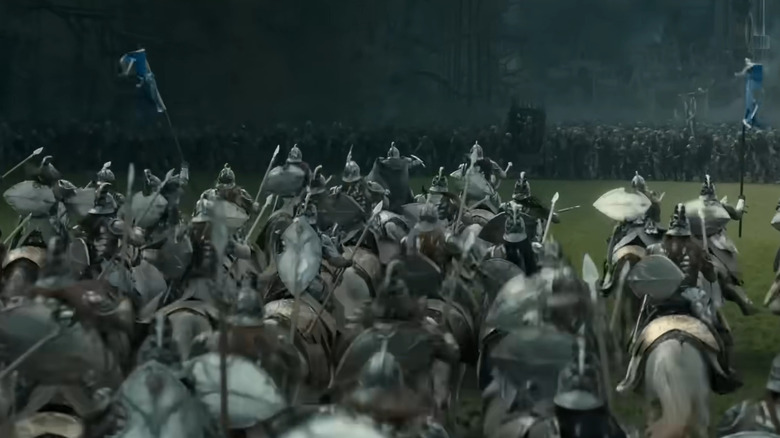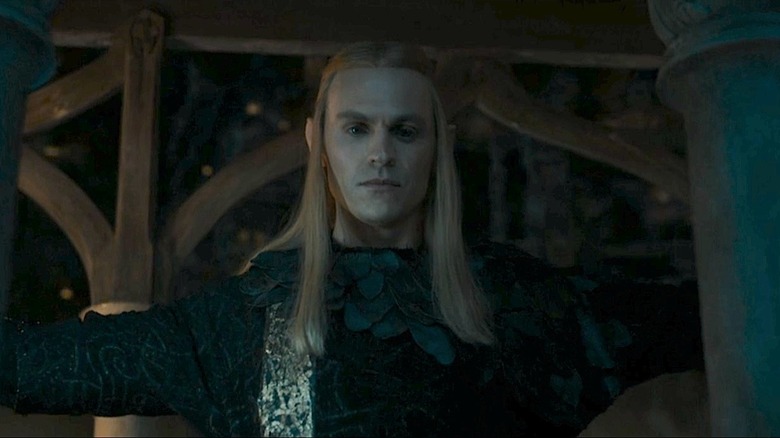The Rings Of Power Season 2 Changes Tolkien's LOTR Timeline In One Key Way
Heads up! This article has some major spoilers for season 2, episode 7 of "The Rings of Power." View first, friend, and then enter.
Episode 7 of season 2 of "The Rings of Power" is chock-full of action (and plenty of Easter eggs, to boot). From Sauron (as Annatar) taking over the defenses of Eregion, to Elrond (Robert Aramayo) and Gil-galad (Benjamin Walker) leading a desperate attempt to break that same siege, the epic installment of JD Payne and Patrick McKay's Second Age story is dripping with Middle-earth drama.
While it's engrossing to watch their vision play out as the show's second season rapidly approaches its finale, it's easy to lose track of some of the major changes to the source material. I say this as someone who is genuinely enjoying the show and yet is painfully aware of how many alterations and adjustments have had to happen to pull this thing off. As I was watching episode 7, I realized that many of these changes can trace their roots back to one thing above all others. They all stem from a single, key change to the Tolkien timeline that has led to a cascading effect — one that is intensifying as the narrative picks up steam. I'm talking about the fact that the show compresses the Second Age into a single period of time. I get that this isn't news. We've known the show was going to condense things down since before season 1 came out, but two seasons in, we're seeing the effects of that decision all over the place.
Compressing the Second Age Timeline
"The Rings of Power" has had limited sources to work with from day one. Tolkien didn't write as thoroughly about the Second Age as he did about the War of the Ring (the events that "The Lord of the Rings" is based on), and the show only had access to certain Second Age-related texts. While the outline is there, most of the stories are brief and disconnected. Characters like Gil-galad have minimal dialogue, while others like Elendil have none at all. Complicating things further is Tolkien's impressive balancing act between immortal and mortal folk. Perpetually living characters like Sauron, Elrond, and Galadriel keep popping up over and over again, and they're thousands of years old by the time of "The Lord of the Rings." Others, like Hobbits, Men, and Dwarves, have an expiration date.
To address the issue, the show has condensed the bulk of the 3,500-year-long Second Age into a single series of events within a mortal lifespan. In 2022, showrunner JD Payne explained the reasoning for this, saying, "If you are true to the exact letter of the law, you are going to be telling a story in which your human characters are dying off every season because you're jumping 200 years in time, and then you're not meeting really big, important canon characters until season four."
Okay, so "The Rings of Power" has crammed thousands of years of events into a single story with a massive cast. Everyone's in the pot at the same time, and they're constantly crossing paths in new ways that weren't in the source material. For the record, I get it. Unless you're going to make a fan-focused documentary, you need to figure out a way to have recurring characters in a drama that is this geographically sprawling and chronologically extensive. Still, this is one of the core struggles of the show. We already saw it in season 1 when the Elven Rings were forged first (they're supposed to come after the Rings for Dwarves and Men). Now, nearly a full season later, episode 7 is the biggest example yet of how many ways the canon story is being altered to fit this unfortunate timeline conundrum.
Comparing the Rings of Power chronology to the Source Material
So, how much is changing the Tolkien timeline impacting the "Rings of Power" story? Let's look at a few of the biggest changes that come to a head in episode 7. For starters, Sauron is still in Eregion when Adar's armies show up to attack. Galadriel is also on-scene. The Dwarven Rings are in circulation, but Celebrimbor is feverishly working on the Nine Rings. The One Ring is nowhere in sight.
In the books, things happen in a more linear, drawn-out format. Annatar shows up in Eregion around 1,200 years into the Second Age. Three centuries later, all of the Rings of Power that end up with Men and Dwarves are forged (although they are originally made for Elves), and Galadriel is already on the other side of the mountains in Lothlórien. Another century later, first the Three Rings of the Elves are forged, and then the One Ring follows. Almost a century after that, an unmasked and angry Sauron personally leads an invasion force (sorry, no Adar, folks) and openly lays siege to Eregion.
See the major differences here? In Tolkien's longer version, Sauron helps forge the Rings of Power in peace, only betraying the Elves after they're complete. He also has the One Ring in hand — or on hand, rather — when he attacks Eregion from the outside. Galadriel isn't even a major part of this portion of the story. The only part that does line up is that in both the writing and the adaptation, Elrond leads an attack to help defend the city (although even then, Gil-galad isn't there).
"The Rings of Power" was never going to be a blow-by-blow adaptation of the source material. However, the decision to boil the entire Second Age into a single point in time has definitely messed with the Tolkien timeline, so much so that, two seasons in, I would say it is the number one thing driving the changes from the source material. We won't know what that means for the remaining three seasons for a while still, but what I can say is that Payne and McKay have their hands full as they try to keep this thing at least relatively on course and in line with Tolkien's larger Second Age vision. Here's hoping they can pull it off!


